New law serves up a cottage industry
July 18, 2013
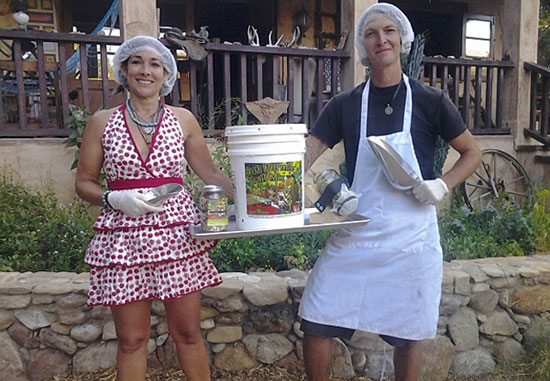
Lisa Cianci and Ben Lawson of Ant Permie's are among hundreds taking advantage of the Homemade Food Act.
Gene Holmon’s spice mix was so good that his Woodland Hills family urged him to sell it. Jessica Schnyder learned to make jam and pickles from her Hollywood chef friend, Amanda Carr.
Kyle and Liz von Hasseln, grads of Southern California Institute of Architecture, were playing with a three-dimensional printer one day when they realized they could make sugar sculptures. Shantal Derboghosian, a Van Nuys engineer, was unemployed when she discovered a gift for baking. Ben Lawson perfected his organic, sustainable trail mix in Topanga when he wasn’t drumming for a Long Beach punk/grind-crust band.
Until about six months ago, few, if any, of them could have profited much from their passions. But today, they and hundreds of others are part of an entrepreneurial boomlet ignited by a new state law allowing Californians to make food for sale from their home kitchens.
The California Homemade Food Act, which created a new category of food production called “cottage food operation,” has been in effect since January and, according to health officials, few places have seized on it with the excitement of Los Angeles County.
Spurred by L.A.’s creative culture and California’s artisanal food movement, a home-based underground of bread makers, cookie bakers, coffee roasters, marshmallow puffers, marmalade canners, baklava peddlers and just about every other imaginable kind of food purveyor has come out from behind the stove to pull permits.
“Our numbers are very high compared to other jurisdictions,” says Director of Environmental Health Angelo Bellomo, who notes that, so far, more than 500 applications have been filed with the county for permission to prepare and sell non-perishable food products at home rather than in expensive leased space in certified commercial kitchens.
Of those, he says, about 200 have been approved; most of the rest are awaiting payment of annual fees ranging from $103 to $254, depending on whether the business is direct sale only or includes sales through restaurants and markets. (Click here and here for the most recent list of permit holders.)
“There’s been a lot of interest on the part of those who have always dreamed of having a home enterprise.”
The development is no surprise to Mark Stambler, a Los Feliz artisan baker whose naturally leavened organic French bread sparked the state law in 2011 after it started flying off the shelves in local cheese shops and restaurants.
“I was selling a good number of loaves each week, and as long as I kept my head down, no one was the wiser,” says Stambler, whose bread was baked in his backyard in a wood-fired stone oven.
But over time, his bread became the talk of foodie L.A., and the Los Angeles Times ran a story, telling readers where they could find it. Within 24 hours, he says, county health inspectors descended on the shop where his goods were being sold and informed customers that it was illegal to sell food that hadn’t been prepared in a commercial kitchen.
Stambler responded with an 18-month crusade to open the system, with the help of his local state legislator, Assemblyman Mike Gatto (D-Silver Lake). The new law applies only to “non-potentially hazardous food” such as bread, preserves, dried foods and other goods whose ingredients don’t include meat, cream or other perishable items. It requires home food producers to complete a course in food processing and the labeling of their products. Those who want to sell their wares in bakeries, markets and restaurants also must undergo a kitchen inspection.
But even with the law’s limitations, the activist baker—who says he lost two-thirds of his business after the county crackdown—says he’s been thanked repeatedly for pushing the changes.
“I’ve heard from people all over the state, saying they really needed this for the added income,” he says.
The cottage food option was certainly helpful for Shantal Derboghosian, who coped with a spell of joblessness by opening Shakar Bakery out of her one-bedroom apartment in Van Nuys. Specializing in custom cakes (her business name is Armenian for “sugar”), the 31-year-old environmental engineer found herself spending six to eight hours on her creations—a labor of love if it’s in your own kitchen, but a hefty bite out of your bottom line if you have to pay an hourly rate for a commercial workspace.
“I was renting kitchen space,” she says, “but they were charging about $25 an hour and it was expensive. My first official client was a three-tier baptism cake for 150 people, with a lot of sculpting—it was a nautical thing, with whales and waves and little anchors.”
Her current project is a 5-foot-tall, flashing tribute cake modeled on the French techno-music duo Daft Punk that she created with the help of Garen Khanoyan, a fellow engineer whose day job is at the Jet Propulsion Laboratory. “These things aren’t quick to do,” she notes.
Neither is building a business, Kyle and Liz von Hasseln say, noting that the new rules have bought them crucial time to scale their custom sugar sculpting business, The Sugar Lab.
The couple says their concept was born in 2010, when they were architecture students at the Southern California Institute of Architecture downtown and a friend announced it was her birthday. “Our thesis at SCI-Arc was on new developments and free-form fabrication, which is the catchall phrase for 3-D printing,” says Kyle von Hasseln. “We were living in a teeny little apartment in Echo Park and we didn’t have an oven. So we decided to try to 3-D print her a sugar cake topper for her birthday cake.”
The idea took months of trial-and-error, he says, but eventually it yielded an extraordinary manufactured sugar sculpture that has since led to a series of custom assignments for birthday parties and weddings in collaboration with a local bakery. Their latest project? A stunning 3-D sugar diamond, done on spec for GLAAD, celebrating the U.S. Supreme Court’s same-sex marriage decision.
“We could invest in commercial kitchen space, but it would be hard for young entrepreneurs just out of grad school with a lot of debt,” he says.
For many artisans, however, the cottage food permits are simply a chance, at last, to see whether their ideas have a market.
“We love food and want to have our own business,” says Schnyder, a 26-year-old Mar Vista restaurant manager who has teamed with her 29-year-old friend Carr to launch Calliope Canned Commodities, a sideline she says expresses their enthusiasm for jams, pickles and Victorian circus musical instruments.
“What we make requires such a slow process and such small batches that you don’t need a lot of space to do it, Schnyder says. “But until now, we haven’t been able to sell it. We’ve just given it away to our friends.”
For Lawson, the drummer, the cottage food program has been a way to market not only his Ant Permie’s trail mix but also his belief in sustainability, local trade and emergency preparedness.
“We all know of local cafes that serve, you know, brownies that some old lady made in an apartment that are so good that nobody drops a dime on them,” he says. “Now that kind of thing can be legal.”
His signature organic snack is made at Cross Bull Ranch, the permaculture collective and retreat where he lives in Topanga, and is sold in airtight, rodent-proof, 5-gallon buckets that, depending on storage conditions, can keep food fresh “for months to years.”
As for Gene “Cappy” Holmon and his wife Paulette, the law has provided an answer both to those who have clamored over the years for his secret Cappy’s Dry Rub spice mix and to the retired couple’s own prayers.
“We had played with the idea for years,” says Paulette, a former costume designer. “Then this law passed, and the Heavenly Father just told us one day, ‘You guys should do something with it’.”
“Everybody seems to like it,” marvels Gene, a 66-year-old disabled veteran and retired small business owner. “Hey, we don’t play golf, so we’ve got to do something, right?”
Posted 7/18/13
Smoke on the water
July 18, 2013
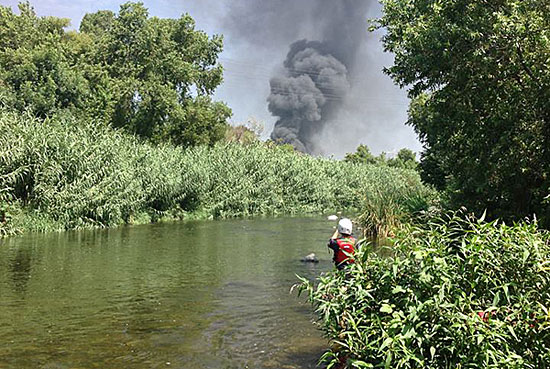
Smoke from Saturday's tanker crash, as seen from the river. Photo/Grove Pashley, L.A. River Kayak Safari
They’ve spotted swallowtail butterflies and hummingbirds, osprey and egrets, lizards and toads. They’ve glided by willow trees, eavesdropped on serenading coyotes, marveled at a hawk enjoying the catch of the day. But what they hadn’t experienced, until last Saturday, was a manmade inferno closing in on what’s rapidly becoming an unlikely recreational hot spot: The L.A. River.
Those who know the river most intimately—the folks who walk, fish or bicycle beside it, along with the hardy souls who take to its waters by kayak—were unnerved, to say the least, by the tanker truck crash Saturday morning in Elysian Valley that sent thousands of gallons of gasoline heading straight toward one of the river’s most popular stretches.
“We came around the bend and there was this huge fiery thing going on,” said Anthea Raymond of L.A. River Expeditions, who had just led a group of kayakers on a river trip Saturday morning and was returning by bicycle to their starting point, a newly-opened pilot recreation zone near Fletcher Drive. “It was a crazy situation because it was just so unusual. Who would have expected that the flames would be shooting through the sewers and blowing up manholes and blow-torching, basically, the foliage on the western side of the L.A. River?”
Amazingly, no one was hurt in the accident—and that includes, apparently, the river itself.
“It was a huge fire and we got really lucky on the environmental part,” said Andrew Hughan, a spokesman for the California Department of Fish and Wildlife. “We can say with very high certainty that no actual gasoline got into the river.”
The high flammability of the gas, the hot weather and a sandbar in the path of the spill added up to a “perfect storm of goodness” that kept the fuel out of the water, Hughan said. Contrary to some reports, he said, “the river itself was not on fire.”
He said, however, that “there is some particulate matter in the sandbar.”
“We’re leaving it there,” he added, saying that it would be more damaging to the environment to remove the material than to allow it to remain in place and let nature take its course.
Some gasoline also got into a massive storm drain near the crash site, which took place at the intersection of the 5 and 2 freeways and prompted major lane and tunnel closures. The city Bureau of Sanitation’s Watershed Protection Division brought in a team to flush things out. “The goal was to suck up all the product that was in the storm drain” with vacuum-equipped trucks, said Steve Pedersen, chief inspector for the division. The gas-and-water mixture was placed in a holding tank, to be hauled away after tests were completed.
Pedersen said contractors hired by the city have since inspected the storm drain “looking for sheen, looking for globules of oil,” and found none.
Lewis MacAdams, founder and president of Friends of the L.A. River, praised the emergency response to the accident but said the welter of official agencies responsible for the river at the federal, state and local levels shouldn’t be too hasty in declaring the situation resolved.
“When I was down there on Monday, there was a very strong smell of gasoline,” MacAdams said.
He said his organization will be watching the situation closely in hopes of ensuring that there is appropriate follow-through on the spill. “The whole idea was ‘We’ll just leave it the way it is because if we turn over the earth, that might disturb something else.’ I think it deserves to be looked at in more depth.”
Paradoxically, some river enthusiasts say that the brush with catastrophe may have been a good thing because of the public attention it has garnered for the waterway, which after decades as a gritty, concrete-lined expanse dedicated chiefly to flood control is experiencing a rebirth as a more natural and recreation-friendly environment. Some of the endeavors underway include a multimillion dollar L.A. River revitalization and bikeway project near Universal Studios, the North Valleyheart Riverwalk from Studio City to Sherman Oaks and the Los Angeles River Pilot Recreation Zone, which was inaugurated this spring, attracting hundreds of kayakers to the river where they can legally paddle for the first time in decades.
“It’s a moment when the way people look at the river and the way people use the river is changing,” MacAdams said. “People are now seeing things like the kayak trips…and suddenly that’s threatened by gasoline coming down the river. And people’s reaction is appalled and worried, rather than ‘Who cares?’ ”
The outpouring of concern has included a series of river photos and videos posted to social media showing the aftermath of the crash.
One video, shot by Grove Pashley of L.A. River Kayak Safari as he led a kayaking group on the river Saturday morning, juxtaposed the idyllic peace of the area known as Little Frog Rapids with images of menacing grey smoke straight out of an urban disaster movie.
“It’s just a really beautiful spot…Normally you hear birds, and all kinds of lovely wildlife in that area. And this particular trip, it was like, ‘Wow, I feel like we’re in a war zone’ because all of a sudden you had these helicopters above us,” Pashley said.
Another video, shot by Raymond, the L.A. River Expeditions kayaking guide, captured the hot orange flames visible from the river bikeway.
By mid-week, guides from both companies were eager to shrug off the drama and get back in the river, which has reopened for kayaking.
“There are still people who, of course, think the river’s dirty, who think it’s dangerous,” Raymond said. “Certainly on this stretch, neither of those things are true…The way to keep persuading those people is to show that people are back out here and we’re having a great time.”
“We did have to cancel a couple of trips, obviously, on Saturday and Sunday,” she added, “and those people are all rarin’ to go. All our trips are sold out.”
Posted 7/17/13
Getting fired up over e-cigarettes
July 11, 2013
These days, e-cigarettes are smokin’ hot.
That guy sitting next to you in traffic, puffing on a pipe-like cylinder as clouds of vapor billow around his head, isn’t getting high—he’s ‘vaping.’
“Vape shops” are suddenly everywhere, some of them offering a lounge-style atmosphere for firing up and partaking of hundreds of flavor options—ranging from AppleCinnana to Yummy Gummy—for the nicotine-infused “e-juice” that creates vapor and delivers an adjustable dose of nicotine.
Big Tobacco is getting in on the act, too, with the makers of Marlboro and Camel preparing to sell their own brands of e-cigarettes, and the company that produces Newports buying the e-cig brand Blu.
But where there’s vape, there’s worry. Even though e-cig users contend that vaping helps reduce or eliminate their craving for dangerous regular smokes, public health experts, government officials and anti-smoking groups say it’s way too soon to assume the new devices are safe. E-cigs, they say, pose potential health hazards for smokers and those around them, and more study is needed to establish the risks.
“It is alarming that we’re seeing so many of these,” said Linda Aragon, director of the county’s Tobacco Control and Prevention Program. “You see a lot more of these vaping stores, or even vapor lounges that are popping up all over the place. We’re seeing much more of that than we have in the past.”

Marketing campaigns include bringing in Playboy's Miss November, Brittany Nola, for an e-cig launch party in New York.
Nicotine is, of course, highly addictive, and there are concerns that e-cigarettes’ kid-friendly flavor palette could attract underage smokers, or even pose an overdose hazard, particularly for small children who happen upon one of the “e-juice” flavor canisters. Researchers have found that propylene glycol, one of the main ingredients in the liquid, can be an irritant when inhaled. Concerns also have been raised about what happens when an array of potentially harmful substances found in some e-cigarettes are vaporized and inhaled by e-smokers and bystanders.
Los Angeles County, acting on motions by Supervisor Zev Yaroslavsky, has banned traditional cigarette smoking on beaches and in county parks, and requires tobacco retailers in unincorporated areas to be licensed. But it has not yet taken steps to regulate e-cigarettes, which can legally be sold in California to customers 18 years of age or older. The state Senate recently approved a bill by Senate Majority Leader Ellen Corbett that would make e-cigs subject to California’s smoke-free laws and ban their use in workplaces, public buildings and other locations that currently prohibit smoking. That bill is working its way through the Assembly and could reach Gov. Jerry Brown by this fall.
“We’ve worked hard to protect the public’s health by banning smoking in places where non-smokers would be adversely impacted,” Yaroslavsky said. “This new trend is a giant step backward from those efforts. Hopefully, the state legislature and the governor will solve that problem before the summer is over.”
Some municipalities around the state also are scrambling to impose e-cig restrictions, ranging from banning their use in public buildings to imposing a moratorium on new vape stores.
Starbucks has cracked down, too, banning e-cigs—along with the traditional kind—in its outdoor seating areas as of this June 1. And the issue’s gone global, with the World Health Organization this week joining the chorus of those urging caution in the use of what it terms “electronic nicotine delivery systems.”
Such warnings come against a backdrop of surging e-cig use. The federal Centers for Disease Control and Prevention reported that 21% of cigarette smokers have tried the electronic version, up from 10% in 2010.
The U.S. Food and Drug Administration says that consumers should not assume e-cigarettes are safe until more testing is done. In 2010, the FDA issued warning letters to five manufacturers for violations including “unsubstantiated claims and poor manufacturing practices.”
Vapers often say that e-cigs have made it easier for them to cut down on regular cigarettes or even to kick the habit altogether.
Aragon, of the county’s tobacco control program, doesn’t buy it.
“The reality is that there haven’t been enough studies to show that there is a sustained ‘quit,’ ” she said. “Our position is that folks who are trying to quit smoking should always use FDA-approved cessation resources, like nicotine patches, nicotine gum, Wellbutrin.”
Greg Simidy, a 21-year-old student who lives in Los Feliz, recently started vaping and said it enabled him to quit regular cigarettes “cold turkey.”
“I got into it with the intention of quitting smoking,” Simidy said, adding that he also “got into it because I saw everyone was doing it.”
On a sunny late morning this week, he was in a newly opened Hollywood store, Vaping Ape, looking to upgrade his equipment. “I want something that gives me the smoke, that feels better in the hand,” he said. And with the availability of tasty flavors like his current favorite, banana nut bread, he sees no reason to turn back.
“I think [cigarette] smoking is a thing of the past, to be honest,” he said.
One of the store’s owners, Jake Bautista, said his customers range from 18-year-olds to “a couple from Burbank in their mid-60s. They come in here every weekend and try new flavors.”
While Bautista said most of his customers want to quit smoking regular cigarettes, there’s also a cadre of style-conscious hobbyists out there who are attracted to the image e-cigs project.
“A lot of younger guys who are into fashion and shoes and stuff, they see their friends blowing clouds and they want to blow these big clouds,” Bautista said.
Bautista contends his product is safer than regular cigarettes and appealing for a number of other reasons, including that it leaves behind no tell-tale tobacco odors.
Michael Jay, a 21-year-old private chef from Oxnard who dropped into the Hollywood store this week, said vaping has helped him cut down his cigarette use and also improved his sense of taste and smell as he cooks.
He’s even turned his parents on to his new hobby.
“My mom and my dad smoked for 20, 30 years and they’re now using vapes,” he said. “It’s good to be able to help them.”
His folks are less enthusiastic, he said, about his rapidly expanding collection of e-cig flavors, which can range in price from $10 to $28, while starter kits for the smoking apparatus start at $65 and can go up to $350.
“I have a fanny pack full of flavors,” he said, rapidly ticking off “gummy blood, unicorn blood, blueberry lemonade, Belgian breakfast, crankberry, dragon’s breath, everything under the sun…They’re very customizable. It’s user-friendly now.”
Posted 7/10/13
L.A.’s story comes to life
July 10, 2013
Los Angeles is young compared to most American cities. It incorporated in 1850, the same year Levi Strauss began manufacturing jeans. But no one can accuse the nation’s second-largest metropolis of being uneventful, and this weekend, a new permanent exhibit at the Natural History Museum of Los Angeles County will begin counting the reasons.
From missions to movies, ranchos to railroads, “Becoming Los Angeles”—a show almost as sprawling as its subject—will take visitors through 500 years of local evolution, tracing the environmental and cultural shifts that turned Southern California into a 21st century global hub.
The 14,000-square-foot exhibition, which opens to the public on Sunday, will not only be the museum’s largest, but will serve as the finale to a decade-long overhaul of the museum, which celebrates its centennial this year.
“We’re looking at Los Angeles history through the lens of how people and the environment have interacted,” says Margaret Hardin, division chief for anthropology and history at the museum. “That’s our overarching narrative.”
Some of the stories are well known—how water from the Owens Valley allowed Los Angeles to grow in the early 1900s, for example. But others are less-told tales, such as the story of the night a surging L.A. River jumped its banks and changed course, or the tale of the grasshopper plague that helped set the stage for the region’s transformation from agriculture to industry.
Tying the narrative together is a swooping steel architectural canopy that touches down at pivotal points in the history of the region. Underneath, four galleries of cultural artifacts give life to the story: the Mission San Gabriel cross, a stuffed grizzly bear, the antique writing desk of California’s last Mexican governor, the headlight of a Southern Pacific locomotive, a souvenir bottle of water from the 1913 opening of the Aqueduct, Charlie Chaplin’s “Little Tramp” costume, the workstation where Mickey Mouse was born.
Sprinkled throughout are interactive multi-media installations. A scale model of downtown L.A. in the 1930s, for instance, lets visitors time travel through the centuries in ten neighborhoods. A bench near the display on the mission era plays a snippet of devotional music when visitors sit in it.
Another interactive exhibit explains the environmental change that turned the Los Angeles region into an annual fire hazard, where invasive, non-native species edged out native, perennial grasses—a process accelerated through “cow poop,” in the words of the museum. This particular display is aimed at one of the museum’s most faithful audiences—little boys.
“We really had a great time,” says Hardin. “There are all these small delights.”

The Natural History Museum's new exhibit on Los Angeles includes four galleries of cultural artifacts.
Posted 7/10/13
DA to fight serial rapist’s relocation
July 9, 2013

Dist. Atty. Jackie Lacey says a Santa Clara judge erred in allowing Christopher Hubbart to live in L.A. County.
Los Angeles County officials do not want the “Pillowcase Rapist” returning to the scene of his crimes.
In the early 1970s, Christopher Evans Hubbart admitted raping more than 20 women in the L.A. region and Orange County, placing a pillowcase over their heads before his violent assaults. Freed in 1979 after doctors at Atascadero State Hospital determined he was no longer a threat, Hubbart went on to rape at least 15 more women in Northern California, serving another eight years behind bars. Paroled in 1990, he promptly tried to sexually assault two more women and was incarcerated again.
Hubbart was considered such a continuing menace that, as his next release date approached in the mid-1990s on a parole violation, the state legislature passed the Sexually Violent Predators Act, empowering authorities to keep serial offenders like him under lock and key in state hospitals until they’re deemed safe for release. When the law took effect in January, 1996, Hubbart was the first state prisoner subjected to its civil commitment requirements. Hubbart appealed to the California Supreme Court but lost.
Now nearly 20 years later, at the age of 62, Hubbart’s getting out again. After hearing testimony from state mental health professionals in April, a Superior Court judge in Santa Clara County ruled that Hubbart was eligible for “conditional release” from Coalinga State Hospital. The following month, the judge determined that, despite strong objections from prosecutors here, Hubbart should return to Los Angeles County, his last address, where he would remain under close scrutiny and supervision—including electronic monitoring—while continuing treatment.
But members of the Los Angeles County Board of Supervisors and newly elected District Attorney Jackie Lacey made it clear Tuesday that they are determined to bring public and legal pressure to bear to keep him out of L.A., where his terrorizing crime spree began.
“This inmate has a long history of horrific violence against women and we must act to keep our community safe,” Lacey said in announcing that her office was filing a writ with the 6th District Court of Appeals in San Jose to overturn the Superior Court’s ruling that Hubbart should be released in Los Angeles. County prosecutors are challenging only the ruling on Hubbart’s domicile.
In the writ, the District Attorney’s Office contends that the court ignored evidence of Hubbart’s long residency in Northern California, where “he committed rapes, sodomy, and forcible oral copulation” at a rate of two women a month until late November 1981. The document goes on to say that Hubbart has no remaining family in Los Angeles County.
Lacey’s action was first announced by her staff during a Tuesday meeting of the Board of Supervisors, which had expressed concern—and anger—over Hubbart’s court-ordered relocation to Los Angeles County.
“Perhaps the judge should take him, if he wants him out so badly, and let him live in Santa Clara in his neighborhood,” Supervisor Michael D. Antonovich said of the Northern California jurist presiding over the matter.
Said Supervisor Zev Yaroslavsky: “I think this county needs to do everything it possibly can to protect its citizens and especially victims of this particular individual’s crimes in past years who reside in this county.”
Should the county’s appeal fail, officials here would be required under the Sexually Violent Predators Act to assist Liberty Healtin locating housing for Hubbart here, which would include such factors as its proximity to the crime victims and their next of kin. But Hubbard would remain under the jurisdiction of the Santa Clara Superior Court.
District Attorney Lacey said in a statement that she already has instructed her staff to begin notifying victims of Hubbart’s Los Angeles County cases about his possible release from custody, which is currently expected as early as November.
Posted 7/9/13
Bringing star power to mental health
July 9, 2013
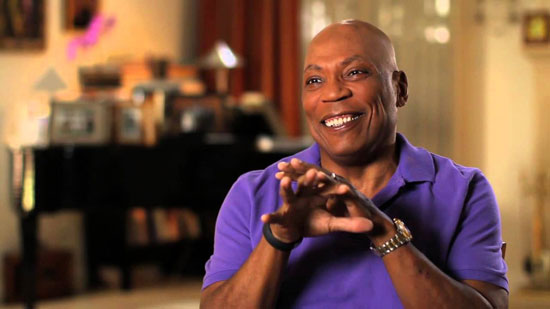
“Profiles of Hope” lets celebrities like producer/director Paris Barclay share how they overcame emotional pain.
It started as a handful of inspirational stories, shared by a few brave volunteers—how this one found help for depression, or how that one dealt with the fear of being labeled “mentally ill.”
Three years later, “Profiles of Hope,” the Department of Mental Health’s online video series, has become an unlikely hit as a public health campaign. Celebrities such as Rick Springfield, Mariel Hemingway and Paris Barclay are sharing their personal stories. Last year, it won a local Emmy in the information/public affairs series category. And on Thursday, the mental health department announced that 60-second versions of the videos have been nominated in this year’s public service announcement category. Meanwhile, a half-hour show comprised of the segments just wrapped its second season on KLCS-TV, the Los Angeles Unified School District’s public television station. And most recently, “Profiles of Hope” has been discussed as a training tool for counselors in the Cal State University system.
“A lot of people have sent emails about how much this has moved them,” says the acclaimed Barclay, who directed and produced much of the award-winning HBO series, “In Treatment.” “More importantly, they’ve also shared their own stories, which is the real goal—to start the conversation. One person reveals what’s happened to them, and another person comes back with their story. It’s part of the human process, the circle of revelation.”
The Department of Mental Health’s public affairs director, Kathleen Piché, said the goal of the videos is “to bust the stigma of mental illness, and not just by hearing from providers and clinics and the usual suspects.” The segments came about in 2010, she says, shortly after the creation of the Los Angeles County Channel. “They asked us if we wanted to do some programming,” Piché recalls.
At the time, she says, the Department of Mental Health was looking for new ways to help people overcome the shame and fear that often accompanies emotional and psychological problems.
“A lot of people say they resist getting help because they’re afraid of how others will see them,” Piché says. “But the earlier people get help, the better their outcomes, and right now, the average length of time from the time people first get symptoms to the time they get help is about 10 years.”
Piché says she initially saw the videos as a series of “day in the life” documentaries that would help viewers realize how many people suffer from some form or another of mental illness. Eventually, she settled on shorter, more intimate testimonials. “There are obviously issues about privacy,” she says. “But there are also people who want to talk about it.”
The department already had an informal speakers roster, as did the National Alliance on Mental Illness, she noted, and after a few calls, she found three current or former department clients willing to share their stories.
Myra Kanter, a nurse and patient’s rights advocate, spoke about her lifelong struggle with depression. Isaiah Hinnerichs, a client at the time in a county program for transitional-aged foster youth, talked about the mental health care that helped lift him out of homelessness. Gary Gougis, now a peer advocate at the Department of Mental Heath, talked about the panic attacks that for years had crippled his ability to function.
“At the time,” Piché says, “nobody knew how impactful they would be.”
Since then, she says, more than a dozen Profiles of Hope have been produced, featuring testimonials from people as disparate as a champion boxer, a combat veteran and a gay Vietnamese refugee. Most popular, however, have been the testimonials of celebrities talking about the ways that they’ve been helped by good mental health care.
Actress Mariette Hartley discusses her family history of suicide and alcoholism. Maurice Benard of “General Hospital” talks about managing his bipolar disorder. Robert David Hall of “CSI: Crime Scene Investigation” talks about how he summoned the emotional strength to rebuild his life after both his legs were amputated in the wake of a car crash. Rock musician Springfield shares his story of overcoming depression.
In addition to the 10-minute taped interviews, which are available on Facebook, YouTube, the County Channel and the DMH web site, shorter versions are being aired as public service announcements.
The spots, which initially were paid for by the County Channel, now are underwritten by funds from the Mental Health Services Act, which taxes income over $1 million to support mental health programs. Each testimonial costs about $13,000 to produce, says Piché, who’s been assisted by DMH Public Information Officer Karen Zarsadiaz-Ige.
But to their audiences, the spots are priceless.
“I think Profiles of Hope was so amazing,” one viewer recently wrote to the department, conveying a special thanks to Barclay for sharing the story of his battle with depression and alcohol. “Recently I recovered from a depressive episode.”
“Rick, thank you for this. THANK YOU,” another commented on Springfield’s YouTube public service announcement.
Next up, Piché hopes, will be a series of interviews with well-known people in politics, sports and public service. Meanwhile, Araceli Esparza, who coordinates Mental Health Services Act programs for the California State University system, says the videos are under consideration as a mental health resource for trainings and workshops on the system’s 23 campuses.
“This just keeps growing,” Piché says. “But I think people are willing to do this because they know that it works.”
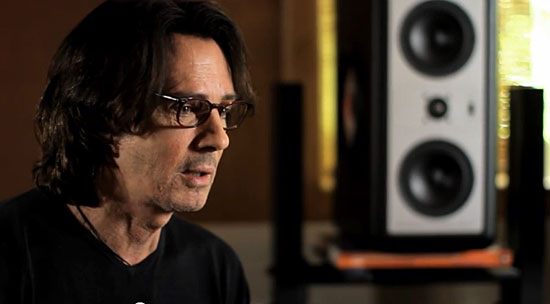
In rock musician Rick Springfield's video, he reveals his battles with depression and suicidal thoughts.
Posted 6/20/13
Meet our new “coroner to the stars”
July 9, 2013
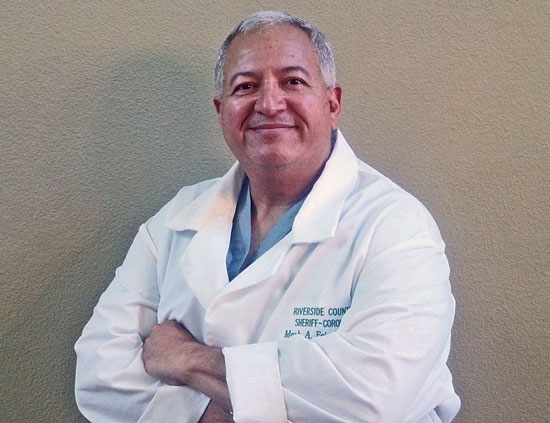
Highly skilled with a scalpel, L.A.'s new coroner will now have to become facile with the celebrity-struck media.
Dr. Mark Fajardo has done thousands of autopsies in the dozen or so years he has spent as a forensic pathologist with Riverside County. From Palm Springs retirees to meth addicts to the renegade former Los Angeles Police Officer Christopher Dorner, he has examined all walks of toe-tagged life.
Still, as the Board of Supervisors named him Los Angeles County’s new chief medical examiner-coroner on Tuesday, Fajardo acknowledged that L.A. has one kind of death to which he’ll have to become accustomed when he steps into the job in August.
“In Riverside County,” he says, laughing, “we run the gamut—except for the celebrities.”
Fajardo, 49, succeeds Dr. Lakshmanan Sathyavagiswaran, who will retire this year after more than 21 years in the position that has come to be viewed as perhaps the nation’s most public coroner’s job.
Marilyn Monroe’s death was investigated by the Los Angeles County Department of Coroner; so were Sen. Robert F. Kennedy’s and Sharon Tate’s and Janis Joplin’s and John Belushi’s and Notorious B.I.G.’s and Michael Jackson’s and Whitney Houston’s and the paparazzo who died earlier this year trying to get a photo of Justin Bieber.
So many high profile cases come through the department, in fact, that in some instances, they’ve boosted the coroner himself to star status. Between 1967 and 1982, Dr. Thomas T. Noguchi came to be known as the “coroner to the stars.”
“I haven’t had to interact with the press much at all, so this will be interesting,” says Fajardo, noting that he hopes to follow Sathyavagiswaran’s lead and delegate most of the media interaction to someone else in the department. Despite a nationally televised stint on the stand during the trial of O.J. Simpson, the current coroner came to be known less for his time in the spotlight than for his competence in rebuilding the department after Noguchi and his successor, Ronald Kornblum, left their jobs amid management lapses and critical audits.
Nonetheless, Fajardo says, when he visited the department, he and Sathyavagiswaran talked at length about the challenges of dealing with death, L.A.-style.
“He told me that you lose all privacy, that you might have any member of the press asking any question at any time, and that you have to be prepared to answer openly,” says Fajardo. “And we talked about the media’s involvement in the case of Michael Jackson. He said there was such a caravan of cameras and paparazzi that they had to utilize a helicopter just to get him from Point A to Point B.”
That said, Fajardo says he’s looking forward to the $275,000-a-year job, which brings him and his wife, a San Bernardino County employee, back to his hometown.
Born at LAC+USC Medical Center, he spent his childhood in East Los Angeles and Pico Rivera. When he was 12, his father, a Los Angeles County deputy sheriff, was killed in an automobile accident on the way to work, and the family moved to be near relatives in Santa Maria.
It was there, while Fajardo was in high school, that the door to his current career opened.
“I took a class at a local community college to learn how to be an EMT,” he recalls.
That skill helped pay his way through his undergraduate training and medical school at UC Davis, where he initially aspired to be an emergency room doctor.
“I actually ran the student clinic at UC Davis,” he remembers. “But the people I played basketball with were pathologists and the friendships I made led me down that path instead.”
At Riverside County, he says, he has performed more than 5,500 autopsies, including more than 350 homicide cases while managing seven full- and part-time pathologists and helping manage a department that handles some 11,000 cases a year.
“This is as far removed as you can get from what most people think of as working as a doctor,” says Fajardo. “But for me, every case is a puzzle I get to solve, hopefully in a way that gives their families closure. I speak for the dead. I try to answer the questions about how they lost their lives.”
Demographically, he says, his caseload isn’t much different than Los Angeles County’s.
“We have our share of homicides,” he says ruefully. “And we’ve had six officer-involved shootings in the last month.”
But while the Riverside County coroner’s operation is large by some measures, serving about 1.3 million people, its constituency is only a fraction of the size of L.A. County’s.
“To me, that’s probably the biggest challenge,” says Fajardo. “Ten million people and all of them have needs. And we have to meet them—we provide a service, just like sheriff’s deputies and firefighters. It’s just that, unless a celebrity dies, people just don’t notice us as much.”
Posted 7/9/13




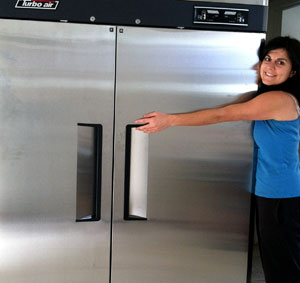


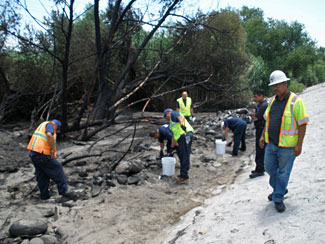

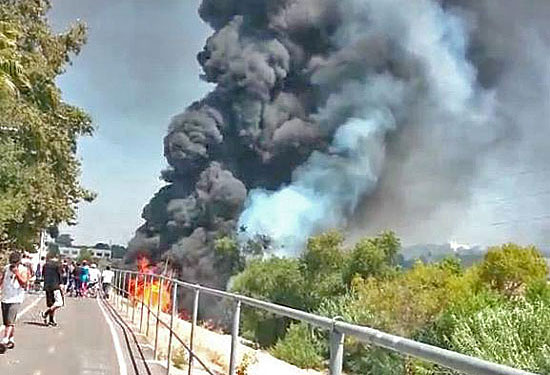

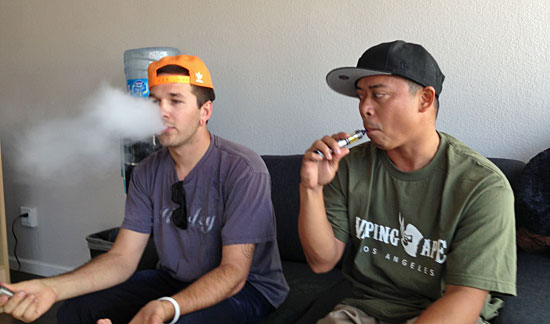

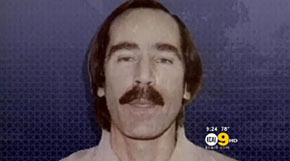
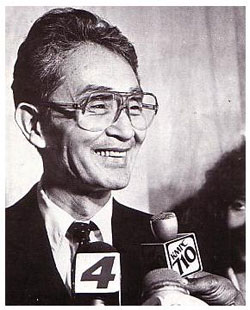





 Check for the latest closure information
Check for the latest closure information








